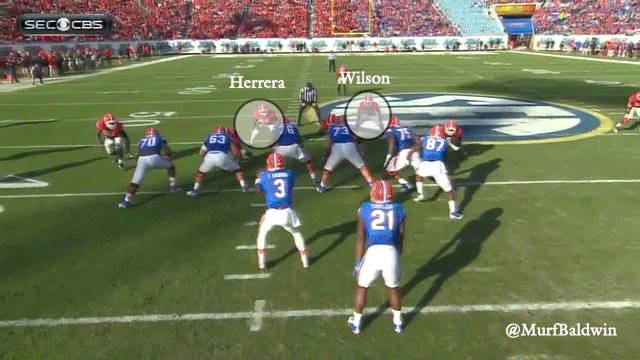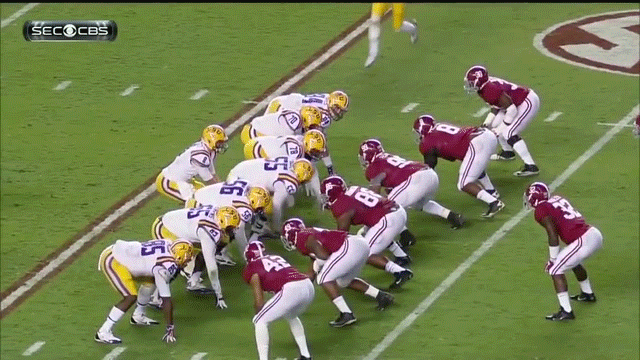Why UGA’s defense is one schematic tweak away from domination
By Murf Baldwin
Published:
For what was once thought to be one of the most feared defensive outfits in the entire country, circa 2005, the University of Georgia’s defense hasn’t exactly struck fear in the heart of the opposition as of late — despite the abundance of certified NFL talent.
Believe it or not, the Bulldogs were once a team predicated on area coverage principles under the guidance of the criminally underrated Brian VanGorder — who eventually became the defensive coordinator of the Atlanta Falcons and now Notre Dame University.
As a 4-3-based outfit, Georgia had no problem developing talent along the front seven in the form of Charles Johnson, Robert Geathers, Quentin Moses, David Pollack, Kedric Golston, Danny Verdun-Wheeler, Chris Clemons and Tony Taylor.
All of those players have scheme-versatility and could fill myriad roles in an outfit designed at generating organic pressure while playing solid, yet conservative, coverage shells on the back end. And speaking of the secondary, players like Tim Jennings, Thomas Davis, Greg Blue, Sean Jones, DeMario Minter, Tra Battle and Kelin Johnson were able to effectively play coverage while limiting the big gain. (Man that was a lot of talent!)
Then future Hall of Fame coach Nick Saban returned to the Southeastern Conference and turned the University of Alabama into a perennial power off the strength of an uber-aggressive, odd-front alignment aimed at creating organized confusion pre- and post-snap for quarterbacks.
After Bama quickly reeled off conference and national championships, programs around the country started to take notice. With VanGorder doing work with Atlanta’s defense, and long-time assistant Willie Martinez failing miserably in his stead, UGA head coach Mark Richt decided it was best to mimic what was going on over in Tuscaloosa and hired former Saban assistant Todd Grantham.
And when it became apparent that the Grantham apple fell far from the tree, Richt reloaded with, perhaps, Saban’s brightest pupil in current DC Jeremy Pruitt (although current Auburn DC Will Muschamp might have something to say about that).
Although Pruitt was able to improve the plight of the secondary, which comes with a major disclaimer that will be revealed a little later, his unit saw similar problems to Grantham’s with being unable to dampen physical rushing attacks.
While some might suggest it’s a personnel problem, I wholeheartedly believe a tweak in scheme could take the D to new heights.
And all that will be needed is a look in the rearview mirror.
Is the “34” Specialty Defense?
I’ve waxed poetic on how much talented personnel supersedes scheme, but that hasn’t necessarily been true as it pertains to the UGA defense.
There’s not one time in the past five or so seasons where I believed the Tide were any more talented than Georgia, but I do believe the former has operated with more scheme-specific fits for that style of defense. While both teams have had effective 0- and 1-techniques — most notably John Jenkins, Marcel Dareus and A’ Shawn Robinson — it’s been the Bama guys who have shown a propensity for getting after the QB in addition to their run-stuffing duties.
Players like Jenkins, 6’3″, 359 pounds, are beginning to get phased out of football with the advent of multiplicative offenses. Teams these days, Georgia included, have the ability to throw a couple of versatile tight ends on the field and run everything from Power O, out of “22 personnel,” to All-Verts from “10 personnel,” without substituting!
So while these players were once thought to be a major factor in run defense, they’ve become a liability as teams are just doing a lot more from base-personnel groupings.
And in a “34” front, the defensive ends need to be nearly 300 pounds but with the ability to wreak havoc in the opposition’s lap. Think about star 5-techniques like J.J. Watt (6’5″ 289 lbs), Muhammad Wilkerson (6’4″ 315 lbs), Sheldon Richardson (6’3″, 294 lbs) and Cameron Jordan (6’4″ 287 lbs), all those guys can equally play both the run and the pass.
It can be said that the most talented front-seven player of the past five seasons, Ray Drew (6’5″, 276 lbs), was a horrible fit for an odd-front alignment as he was too light to be a true 5-tech, and he wasn’t athletic enough to be a standup outside linebacker.
But he could’ve been an absolute terror in VanGorder’s scheme as a one-gap-penetrating 3-technique. And players like Mike Thornton, 6’1″, 296 pounds, were too one-dimensional to make an impact in Pruitt’s subpackages.
And as it pertains to the second level, Bama has had a run of scheme-specific fits at inside linebacker who would go on to be drafted relatively high: Rolando McClain (first round, eighth overall), Dont’a Hightower (25th overall) and C.J. Mosley (17th overall) — with its current star, Reggie Ragland, looking every bit the part of a potential first-round selection. Since Georgia’s move to the “34,” only current St. Louis Rams’ star Alec Ogletree (6’3″, 225 lbs, selected 30th overall in 2013) has been on that level. (And even he was a converted safety who was/is a better fit as a weak-side LB who receives the benefit of working in optimal space and chases down plays).
Players like Akeem Dent (6’1″, 239 lbs), Amarlo Herrera (6’1″, 250 lbs) and Ramik Wilson (6’2″ 230 lbs) all appeared to be better fits in an even-front scheme — especially the latter two — as they struggled to get off blocks and play in reverse (two things that are crucial for success in such a scheme), which usually reared its ugly head against physical rushing attacks.
Here we see a prime example of why this particular scheme calls for LBs who can stack-and-shed blocks: Florida, running “Power” out of a Pistol formation, blocked both Herrera and Wilson with two linemen — one on a combo, the other on a back-side pull — exposing their inability to disengage from blocks. Don’t misconstrue that statement as to say either player weren’t any good, as that’s far from the truth.
But both excelled at shooting gaps — when covered up — and chasing down plays. Meaning, both would’ve been even more effective in a 4-3-based scheme that allowed them to play behind four linemen; it’s a style of play.
I can identify with both of these guys as I struggled in the same scheme but excelled out in space in a “43.”
So when I study a play like the above sequence, I can certainly empathize with the results.
Now check out former Alabama ILB Trey DePriest’s (6’0″, 254 lbs) ability to get off blocks. Although he didn’t possess the prerequisite athleticism to play in reverse or shoot gaps, he was money at the stack-and-shed technique, which played well in conjunction with Mosley’s sideline-to-sideline to style.
Looking ahead, Georgia’s signing of the 6’3″, 255-pound Natrez Patrick looks like a shot in the right direction for this type of scheme. Furthermore, when you consider Patrick is a converted defensive end, you get a feeling that disengaging from blocks shouldn’t be a problem. But he will be surrounded by other players — Tim Kimbrough (6’0″, 230 lbs) and Reggie Carter (6’1″, 231 lbs) — who appear, on film, to be better fits for an even-front defense.
And it seems like such a waste to not have new uber-recruit Trenton Thompson play as a one-gap penetrator — as this kid is that special (click here to read my analysis of Thompson).
Which brings me to my next point…
But you’ll have to tune in to part two where I examine why tweaking the scheme would take advantage of one of the, if not the, most talented front sevens in the nation.
Former linebacker/safety Murf Baldwin specializes in diving deep into the Xs and Os of the game with the goal of educating and entertaining while bringing fans closer to their team.











